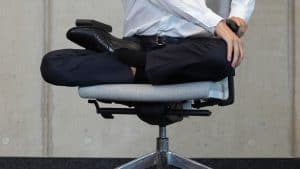Have you ever experienced deep pain and numbness radiating from your pelvis region?
Does sitting for even a while result in a feeling of pins and needles?
Do you experience pain while doing physical activities like running or climbing up the stairs?
If yes, then you might be suffering from Piriformis Syndrome.
Table of Contents
- What is Piriformis Syndrome?
- How to Sit With Piriformis Syndrome?
- Does Sitting Aggravate Piriformis Syndrome?
- How Long Does it Take for Piriformis Syndrome to Heal?
- Should You Rest With Piriformis Syndrome?
- The Bottom Line
What is Piriformis Syndrome?
Piriformis is a muscle that runs from the base of the spine to the two thigh bones and is responsible for most of the hip and leg movements that we need in order to walk and maintain balance. This muscle stabilizes our lower body and enables the thighs to move away from the body, making it possible for us to run and sit.
So, what is Piriformis Syndrome?
Inflammation of this muscle due to unhealthy lifestyle or injury leads to Piriformis Syndrome, a neuromuscular disorder, wherein the muscle spasms and puts pressure on the Sciatic Nerve, which runs along or through it toward the base of the legs. This nerve compression, known as Sciatica, is one of the symptoms of Piriformis Syndrome and results in pain and numbness in buttocks, legs, and back.
How to Sit With Piriformis Syndrome?
You can’t avoid sitting, but you can make it so that it affects your body in a much less negative way. There are a number of precautions you can take to elevate the situation, and just by following a few simple steps, your chances of suffering from Piriformis Syndrome would lessen by a lot. Let’s take a look at five such simple changes:
1. Practice Good Posture
It may take a while for you to ingrain it as a habit, but as long as you are successful in perfecting the correct posture, you can win half the battle just like that. Sit upright and don’t slouch, your feet should be firmly pressed to the ground and should be totally flat (sorry heels), parallel to it, bearing your weight evenly.
This way, you can elevate the pressure your piriformis muscle and spine are put under. Lesser pressure means lesser chances of tightening and spasm, lesser compression caused to the sciatic nerve, and eventually lesser chances of developing Piriformis Syndrome and lesser pain and discomfort.
2. Choose the Right Chair
By ‘right’ chair, I mean the one with a firm seat. A seat or cushion that doesn’t sink down after sitting, not even slightly. In fact, the firmer the better, as a firm surface is able to properly support the hip joint and the lower spine. You will get pain relief from the pain in the buttocks.
On the contrary, a softer surface might feel comfortable at first, but it increases the pressure on your hip region. It is also very easy to sink into a bad posture on a softer surface than on a firmer one, resulting in higher chances of developing a problem.
Remember, sitting upright on a surface, your hips must be in level with your knees and absolutely can’t be below them. This is to make sure that your lower back and pelvic muscles have proper support and also to avoid any unnecessary pressure that might result in a long-term problem.
3. Use a Seat Wedge
It is most common in elderly people whose spinal disks have worn down over time, but even in younger people, consistent bad posture when they sit can result in inflammation or swelling of spinal disks. These inflamed disks, in turn, put pressure on the piriformis muscle, which is connected directly to the lower spine.
What a seat wedge does is help us in maintaining the right posture, which can elevate the uneven pressure on the spinal disks, making it easier for them to do their job of holding our back together. With the right posture that allows our lower back and hip muscles to relax, the chances of triggering Piriformis Syndrome or a relapse are naturally much lower.
4. Lumbar Support Pillows
The lumbar region is the lowermost part of our spine, the one that eventually connects with the piriformis muscle and the surrounding nerves. So all the lower back pain one might experience could be due to this part of the spine, which suffers the most from bad posture.
The lumbar area has a natural curve that most of us know about but still fail to adhere to while sitting on a chair, leaving this area unsupported or poorly supported. This can lead to a number of problems with Piriformis Syndrome being just one of them. That’s why people are advised to use back support while sitting or, more specifically, the use of lumbar support pillows is encouraged.
These come in various kinds and all sizes, for example, half-moon, circular, full, etc. and can be used anywhere from office chairs to car seats and at home. They provide the right kind of support our lower back needs, and you can choose the degree of firmness of a pillow according to your own needs.
Of course, you don’t need to specifically buy them and can just create your own using a rolled-up towel or two! In short, anything that works for you and allows your lower back to be properly supported while sitting, can be used as lumbar support.
5. Take a Walk
Sitting for long hours is never advisable even under normal conditions, so if you are suffering from Piriformis Syndrome or experiencing pain in general, it might be better to take short walks every 20 minutes or so. Actually, not ‘might,’ but it certainly is highly recommended not to sit still for a long time and take a break every once in a while.
Taking a short walk and stretching the muscles, giving them space to unclench and release the build-up tension is really important as it is this tightening of the muscles over the time which, in addition to being unable to relax, leads to the build-up of taut muscles causing spasms and compression of nerves.
So taking short walks would not only help in elevating the pain if you are suffering from Piriformis Syndrome or just starting to get better but will also help in the overall relaxation of the body, making you feel better. Moreover, taking a walk for a short while helps in dealing with back pain and improves circulation, making you almost always feel energized afterward.
Does Sitting Aggravate Piriformis Syndrome?
In fact, sitting for long hours with bad posture might eventually become the cause of Piriformis Syndrome. Though this disorder is painful, it is treatable, and with some guidance from the physiotherapist and a few lifestyle changes, people suffering from it can get better in just a few weeks.
But if you have a habit of sitting for long periods of time, in a bad posture or on an unsuitable surface, which puts undue pressure on the base of the spine and the Piriformis muscle connected to it, the situation can get from bad to worse just as quickly.
That said, if you are an office worker who needs to spend hours upon hours in front of the computer on a chair or a person who needs to drive a lot (cars, trucks, etc.), the situation can be a bit tricky for you. You can’t avoid sitting for long hours, increasing the chances of triggering the syndrome, or aggravating it if you already suffer from it.
In that case, you can only make the best out of the situation and integrate habits that help you counter it in your day-to-day life and work.
How Long Does it Take for Piriformis Syndrome to Heal?
It differs from person to person and depends on a number of factors such as the extent of the injury, for how long the symptoms were present before the diagnosis, the chosen method of treatment and recuperation, and finally, the current lifestyle. Keeping all these factors in mind, it may take anywhere from a few weeks to months for Piriformis Syndrome to heal.
Treatment methods may include physiotherapy, non-steroidal pain relief medicines, electrotherapy, or even surgery in the worst-case scenario. You can also try regular massages to help the muscles relax, applying ice packs for around 20 minutes every few hours, and applying heat pads to relieve soreness and pain. But only use heating packs if you don’t have swelling, or it might aggravate the condition.
Also, how seriously the patient is taking their condition and following the guidelines plays a big role in recovery. There are many instances when, after a steady improvement, people grew careless and reverted back to old habits, eventually resulting in a relapse. So it’s of utmost importance to keep vigilante and not take the condition lightly if you wish for a complete recovery.
Should You Rest With Piriformis Syndrome?
It depends on the body’s condition and on one’s definition of ‘resting.’ Sitting for long periods of time is a big no-no, and so is doing any sorts of vigorous activities like running or playing sports as they might trigger the condition. Lying down can provide comfort, but that could only act as a temporary solution, as life goes on regardless of whether you are in pain or not.
So proper exercising and stretching is the way to go! Under the guidance of your doctor and an experienced physiotherapist, come up with exercises best suited for you and make sure to stick to them. Exercising properly while keeping all the precautions, like how to sit and what to avoid, in mind is the only way for a complete recovery and minimizing the chances of a painful relapse.
The Bottom Line
As I already said, Piriformis Syndrome is painful but not unbeatable. So continue with your life and responsibilities just like before without worrying much, but do keep in mind all the points discussed here.
If the pain in the buttocks, hip joint, sciatic nerve, or any muscle becomes unbearable, then make sure to take proper medical advice. Pay special attention to your posture and that your body is getting ample space and time to relax. Eventually, everything depends on your initiative and determination, so don’t let the pain hold you back and do your best to take care of your body!

